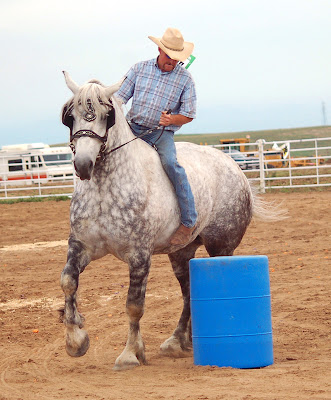
Long rein horses should therefore be worked regularly under saddle as well. Many horses tend to push their croup up and to go downhill in the canter, which is not easy to correct at the long rein for the same reasons. For instance, it is difficult to develop a good lateral bend, due to the lack of weight and leg aids. Of course, long reining has its limits and drawbacks as well. This way, both types of work improve each other, and the rider develops a more complete and more differentiated sense of feel. Back in the saddle, you can correlate this visual impression you gained at the long rein with the feel in your seat, legs, and reins. At the same time you feel the horse’s entire body in your hands. Walking behind the horse on the long rein, you gain a visual impression of the back and hindquarters, bend and balance. By the same token, the rider improves in the saddle as a direct result of this kind of work, because he can see at the long rein what he is feeling under saddle. The horse improves under saddle as a direct result of long reining, as you can explain certain things better at the long rein, while other can be treated more efficiently under saddle. All mistakes and problems that arise under saddle will therefore show up even more clearly at the long rein. Should a problem arise under saddle, whose cause is not immediately obvious, you can often identify the root cause more quickly and easily at the long rein, since the mechanics of the haunches are directly visible, and you are unable to mask mistakes through weight and leg aids. Long reining is also a great diagnostic tool, since cause and effect chains play out clearly visible right in front the rider’s eyes.

As he is not sitting on the horse, he can focus on the rein aids, without having to worry about the seat. By being able to see precisely where each leg is and what it is doing at any given moment, he can acquire the feel for the correct timing of the aids, which will help again under saddle.

The rider can learn a great deal about the technical, biomechanical aspects of horse training, since he has the entire horse’s body, and especially the legs, in plain sight. I have always found that horses generally like this type of work, because on the one hand it is easier for the horse, since he does not have to carry the rider’s weight, and on the other hand it creates a closer bond between human and horse, as they literally work “side by side” and the human has to expend at least as much energy as the horse. Long reining is an excellent training technique to support the work under saddle, which is quite beneficial for both the horse and rider, and which can be a lot of fun for both. Thomas Ritter © 2013 (article appeared in issue 18 (2014) of BHM)


 0 kommentar(er)
0 kommentar(er)
